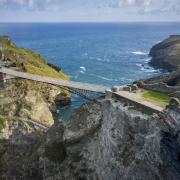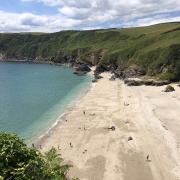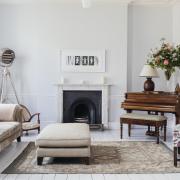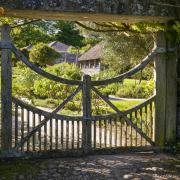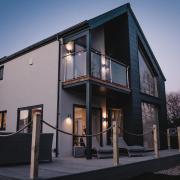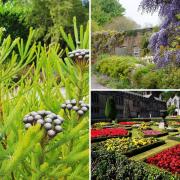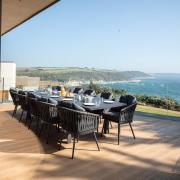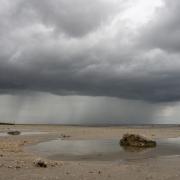St Austell in Cornwall is known as white gold - thanks to its China clay history - and it is fast becoming a contemporary art centre with new installations and exhibitions
Renowned artist Kurt Jackson responds to the industrial landscape of Cornwall’s clay country in his latest exhibition.
Blending art and industry this show at the new exhibition space at Wheal Martyn's visitor's centre brings Kurt Jackson's unique view of the area into large semi-abstracted canvases and mixed media work incorporates real elements of the landscape. The exhibition includes new mixed media paintings ranging from huge tarpaulin-sized canvases to small intimate studies, as well as a number of ceramic pieces.
‘This is one project in a lifetime's response to Cornwall, the culture, topography and environment,’ explains Kurt. ‘Cornwall proves to be a continual source of inspiration for me, inexhaustible in supplying thought-provoking material for my creativity. Whether it's the fauna and flora, the community, the new industries or the heritage, all is ripe for the picking; all have an impact on the environment and this in turn affects us all.’

The son of artist parents and a dedicated environmentalist, Kurt Jackson’s holistic approach to his subject blends art and politics providing a springboard to create a hugely varied body of work unconstrained by format or scale. His work ranges from his trademark visceral plein air sessions to studio work and embraces an extensive range of materials and techniques including mixed media, large canvases, print-making and sculpture. His latest work is inspired by time spent watching workers in the pit as they extracted and transported the china clay in this extraordinary man-made landscape.

Kurt’s focus on the natural world has led to artist in-residencies on the Greenpeace ship Esperanza, the Eden Project and Glastonbury Festival, which has become a staple of his annual working calendar. And his time ay the working at Littlejohns China Clayworks proved to be one of the most challenging.
‘Throughout my creative career I have been inspired by Cornwall's extractive industries to make bodies of work about, and in, the geological workplace, alongside workers – responding with paintings, drawings, printmaking and the written word,’ he says. ‘Initially it was the plight of tin mining in Cornwall that took me underground in 1996: the South Crofty series. This was followed by Carnsew, a working granite quarry, toured from 1998 and then the slate quarry in Delabole which I had known since my childhood.’

‘It seemed logical to me that these should be followed by the china clay industry. After an interview with Imerys and a health and safety course I was given access to the visitors viewing platform at Littlejohns Clayworks. I soon found there were limitations to this one location in terms of viewpoint, angle and distance from the ‘action’. With more conversations and form filling I was eventually allowed almost free roam (up to a point), however my van was required to have a large flag on the roof and I was dressed in high vis and safety wear.
‘When working alongside the high-pressure hoses and hosemen I would accompany them in their own Land Rover. I worked at Littlejohns throughout that winter and into the spring until I felt that I had covered all the different aspects of china clay mining.’
Alongside paintings in a variety of media and scale – from huge tarpaulin-sized canvases to small lap-size studies, he also filmed and wrote.

The scale of his work is a response to the sheer size of the clayworks. ‘I think I was amazed and quite overawed by the size of the pit,’ he adds. ‘The dinky toy-size work vehicles were actually enormous multi double-decker bus-sized in close-up, and the workers were nearly invisible, negligible, in the sheer vastness of the pit. Also the dynamic nature of the mining with the entire landscape being shifted again and again was astonishing - hills and valleys, streams and lakes were temporary - nothing was static.’
His latest work captures the different stages of extraction: the blasting, clawing at the face, breaking up the rock, the washing and hosing, transportation, settling and conveyance. Some pieces actively incorporated kaolin and sand, the stent and grit. He also collaborated with a potter, John Swan of Pendeen Pottery, to make a series of ceramics using Cornish china clay in porcelain and stoneware.

'We all (residents or visitors of Cornwall) are aware of ‘Clay Country’, that area over there where something to do with china clay goes on; where the Cornish Alps are located - those conical sky tips on the skyline. It was only after spending time there and being amongst the workers in situ that I gradually came to understand the process, but also the history of the area, the heritage, and importance of the industry to the families and community whose ancestors have worked here for many generations. I hope for an awareness about this side of Cornwall, this area off the beaten track that paradoxically produces an ingredient in all our lives. Kaolin is present as an everyday part of so many things we use from toothpaste to paper, plastics to ceramics.’
‘Our relationship with the natural world underpins everything, how we treat nature is reflected in our own fate,’ he adds. ‘This must motivate all of us.’
The exhibition will be on display in the museum’s brand new gallery space until 5 September.
wheal-martyn.com
kurtjackson.com





